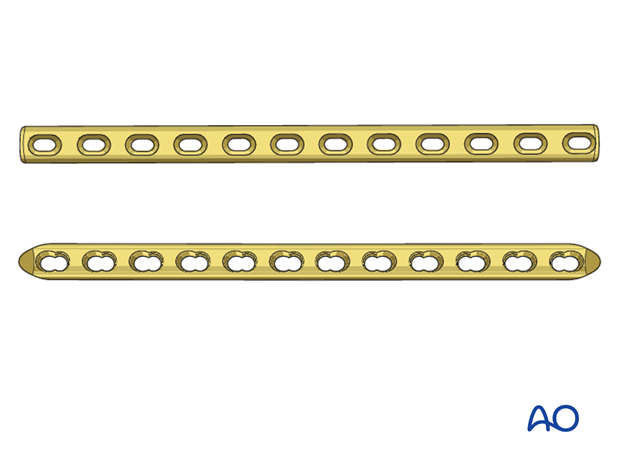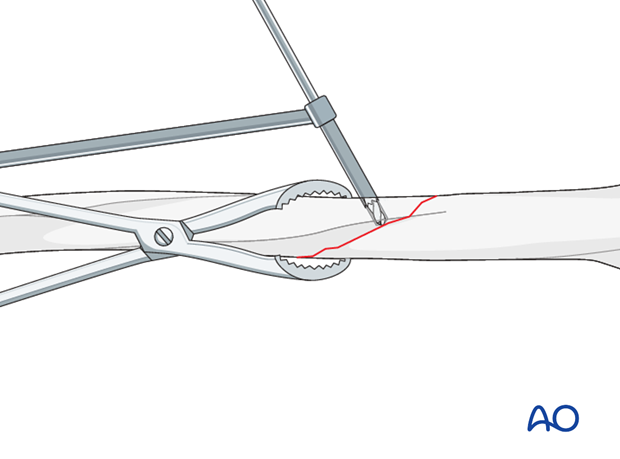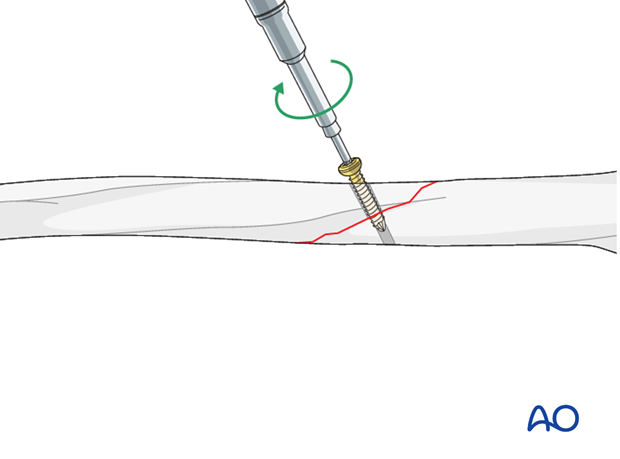ORIF - Lag screw with protection plate
1. Principles
Lag screws with neutralization plate
Spiral or long oblique fractures can often be reduced and held with lag screws, but the durability of fixation is inadequate, and the protection of a neutralization plate is needed. This prevents screw pull-out from repetitive or excessive loading.

Open fractures in the humeral shaft
Adequate surgical debridement is the crucial first step in the care of any open fracture.
Read more about the treatment of open fractures in the humeral shaft.
2. Choice of implant
Plate types
Either a standard plate or a plate with locking head screws (LCP) can be used as a neutralization device. In poor quality bone the use of an LCP is recommended.
Depending on the fracture location and the planned plate position it might be necessary to bend and twist the plate.

Plate length
It is crucial to use a plate that is long enough on each side of the fracture. Plate length is more important than the number of screws for ensuring stability.

3. Plate position
Introduction
The choice of plate position depends on the fracture morphology and location, the radial nerve pathology and the surgeon’s preference. The anterolateral, anterior, and posterior surfaces of the humeral shaft are all possible choices.
The medial surface is generally reserved for complex reconstructive procedures ie vascular repair in complex fractures. Since the use of this plate position is rare it is not further shown.
The location should allow sufficient plate length on both proximal and distal segments, with a minimum of three holes for each.

Anterolateral or anterior plate
An anterolateral plate fits well from very proximally to the distal fifth of the humerus and is selected if proximal and middle third fractures are present.
A plate in this position should provide stable fixation of the fracture and minimal soft-tissue damage.
Proximally, the plate may interfere with the deltoid insertion if it is placed laterally, or with the long head of the biceps tendon if the plate is positioned anteriorly. To overcome these problems the proximal end of the plate can be tunneled through the deltoid insertion.

Distally the plate may be applied to the anterior or lateral surfaces.
Depending on the chosen positions for the proximal and distal plate ends, the plate may need to be contoured and/or twisted to form a helix.

Neurological considerations should be taken into account. The radial nerve is at risk if the plate is applied to the lateral surface in the distal third. The plate should be twisted to ensure that the distal end avoids damaging the radial nerve.

The innervation of the brachialis muscle is derived from both the radial and musculocutaneus nerves. The radial branch is at risk if the plate is applied to the anterior and anterolateral surfaces in the distal third while retracting the entire brachialis muscle medially. To avoid this it is safer to split the brachialis muscle.

If a small open fracture wound is present, the approach is made separately. Only if there is a large wound, after debridement, consider using the wound itself, with its necessary extensions, for plate insertion.
Posterior plate
The posterior surface is difficult to access proximally and limited by the axillary nerve. Therefore, posterior plating is best suited for middle and distal third fractures.
It is important to protect the radial nerve and its accompanying vessels in the spiral groove. If the plate interferes with the radial nerve, the plate must be placed underneath it. The course of the radial nerve in relation to the plate holes should be mentioned in the operation note. This will reduce the risk of accidental nerve damage if the plate should ever need to be removed.

4. Patient preparation and approaches
Patient positioning
Place the patient in a supine position or, alternatively, a beach chair position for placement of an anterolateral or anterior plate.
For placement of a posterior plate, a prone or lateral decubitus position is normally used.Approaches
The approach is selected depending on the chosen plate position.
For an anterolateral plate the anterolateral or extended deltopectoral approach may be used. For a more distal anterior or lateral plate, an anterolateral or lateral approach may be used.
The posterior surface can be accessed with a posterior approach (triceps-split or triceps-on approach).5. Reduction
Manual reduction - limb realignment
Begin the reduction with traction on the distal humerus restoring bone length, tension in the soft tissues, realignment of the axis, and rotation.
Clear any interposed soft tissue by direct exposure. Preserve as much soft-tissue attachment as possible.

Pointed reduction forceps
Definitive reduction and fracture apposition is best performed with bone forceps, preferably with a pointed reduction forceps.
Align the fracture anatomically before tightening the forceps. It may be necessary to readjust to achieve this. If soft tissues have been preserved, the reduction may be difficult to assess.
Apply the clamp perpendicular to the fracture plane. Its position will mimic that of an appropriately placed lag screw. Place the clamp near, but not exactly, where the planned lag screw will be inserted.
Make sure that the clamp does not lie within the planned plate position.
Note: Care should be taken in poor bone quality. The reduction forces need to be applied gently to prevent further, iatrogenic fractures.

Reduction with external fixator or distractor
In nonunion with chronic shortening of the humerus it may become necessary to distract the fracture with an external fixator.
Oblique fractures are inherently unstable, so that an external fixator or a distractor may be necessary to maintain length. Such devices minimize soft-tissue injury if manual reduction is relied upon while the plate is being attached.
Insert proximal and distal pins outside the planned plate location. Take care not to injure the radial nerve. If in any doubt use incisions wide enough to allow palpation or direct visualization of the radial nerve.
Complete reduction may require additional correction of angulation or rotation. Folded linen bolsters under the fracture often help.

6. Lag screw fixation
Planning for lag screw
Plan lag screw location so that, if possible, the screw heads are outside the chosen area for the plate.
Place the lag screw centrally across the plane of the fracture, and perpendicularly to it. For longer fractures insert a second lag screw to increase stability.

Drilling gliding hole
Use a 4.5 mm or 3.5 mm drill (according to screw size) to create a gliding hole, located centrally across the fracture plane, away from the fracture line, and angled perpendicularly to the fracture plane, at the chosen location.
Using an appropriate drill sleeve, drill through the near cortex.

Drilling pilot hole for thread
Insert an appropriately sized drill sleeve through the gliding hole to contact the far cortex. Drill through this with the appropriate drill for the pilot hole, 3.2 mm for large fragment screw, 2.5 mm for small fragment screws.

Screw insertion
Measure the length of the screw, and if necessary tap the far cortex. Insert the screw, tightening it carefully. For longer fractures, a second screw is inserted in an appropriate location and orientation, using a similar technique. Both screws should be perpendicular to the fracture plane at the site where they are inserted. Each hole should pass through the middle of the fracture spike, or of the fracture plane of the other fragment.
Note: Deep countersinking is often unwise for the thin humeral cortex although shallow countersinking reduces the risk of fissure fracture beneath the screw head. This requires careful surgical judgement.

7. Plate contouring
Depending on the planned plate location, some contouring of the plate is likely to be necessary to fit the plate to the bone perfectly so that tightening its screws does not displace the fracture. This is true distally, posteriorly, and also on the anterolateral surface centrally. Sometimes twisting the plate around the shaft of the humerus provides a better fit and allows a longer plate.
Shape a malleable template to the bone surface. Use this template as a guide to shape the plate to fit the bone.
Use care to avoid fracture displacement while contouring the plate.

8. Plate fixation
Application of the plate
Expose the bone sufficiently for plate application but do not strip the periosteum.
Center the plate over the fracture and hold it with a clamp in position.
Alternatively, and to confirm correct contouring, use a well-placed screw to hold the plate.

Pitfall: fracture displacement
Be careful not to displace the fracture, as initial lag screws may lack strength. If possible, leave a reduction clamp across the fracture during plate application.

Insertion of plate screws
Confirm that contouring of the plate is appropriate and that its position is satisfactory.
Insert the screws through the plate. Screws close to the fracture site are placed first.
The number of screws depends on the type of screws, the fracture morphology and the bone quality.
Using locking screws, two bicortical screws on each side may be sufficient. Otherwise, it is recommended to use 6 fixation points on each side.

9. Final radiological assessment
Check for proper reduction and implant positions with image intensification in AP and lateral views.
Confirm also a proper torsional alignment of the humerus.

10. Aftercare
Principles
The aim of any surgical fixation of humeral shaft fractures is a stable osteosynthesis of the fracture allowing early passive and active motion. This is crucial to prevent elbow stiffness.
The rehabilitation regimen should take account of any damage to soft tissues, either as a result of the injury or due to the surgery. It also needs to take account of the security of the fixation.
Immediate postoperative care
Carefully examine the patient for neurological deficits and pulses.
Early treatment
In the beginning lymph drainage and elastocompressive bandages may be helpful.
Consider a sling for pain relief within the first days.
Treatment for refixation of deltoid detachment
If the deltoid was detached and reattached, active deltoid contraction should be delayed for the first six weeks.
Mobilization
In the early phase the rehabilitation consists of classic maneuvers eg overhead motion exercises.
Rehabilitation should address the entire upper limb.

Exercise against resistance
Depending on the bone quality and compliance of the patient, exercise against resistance might be limited.
Follow-up
Clinical and radiological follow-up should be scheduled at least 6 weeks, 12 weeks and 6 months after surgery and continued until a bony healing is confirmed.
Hardware removal
Typically, humeral plates are left in situ indefinitely.
If removal is considered, bony healing should be confirmed. Plates are not normally removed for at least one year after surgery.
Be aware of the risk to the various nerves when dissecting the soft tissues to gain access to the distal humerus for removing anterior or anterolateral plates.
As the radial nerve runs over a posterior plate, removing this plate should only be considered with great caution, and the patient must be well informed about the risks. The original operation note should describe the relation of the nerve to the plate and should be reviewed before plate removal.













